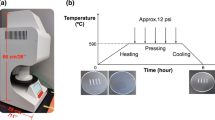Abstract
Micro-channels for microfluidics were fabricated in soda-lime glass through imprinting technique, and then joined to another soda-lime glass slab by thermal assisted direct bonding (TADB). The joined samples were characterized before and after TADB by optical and scanning electron microscopy (SEM) and surface profilometer and shear strength test. The integrity of channels is maintained also after the bonding. The bonded interface between the two glass slabs was found to be without impurities, bubbles and cracks; good bonding strength of 32 MPa between two glasses was obtained as well. These techniques are simple and low cost, suitable for mass production of glass based micro-fluidic devices.






Similar content being viewed by others
References
Chen Q (2008) PhD Thesis, Electronic Devices, POLITECNICO DI TORINO, Italy
Chen Q, Milanese D, Chen Q, Ferraris M et al (2005) Direct bonding and ion exchange for waveguide lossless splitter fabrication. Published by ICG/ISG 2005, p5
Chen Q, Chen Q, Milanese D, Ferraris M, Fokine M (2007) Direct bonding and imprinting techniques for micro-fluidic devices fabrication in commercial soda-lime glass, Patent N. TO2007A000345
Chen Q, Milanese D, Chen Q, Ferraris M et al (2008) Fabrication and direct bonding of photosensitive multi-component silicate glasses for lossless planar waveguide splitter. J Non-Cryst Solids 354:1230–1234. doi:10.1016/j.jnoncrysol.2006.11.045
Cheng J-Y et al (2005) Crack-Free direct-writing on glass using a low power UV laser in the manufacture of a microfluidic chip. J Micromech Microeng 15:1147–1156
Czaplewski DA, Kameoka J, Mathers R, Coates GW et al (2003) Nanofluidic channels with elliptical cross sections formed using a nonlithographic process. Appl Phys Lett 83:4836–4838. doi:10.1063/1.1633008
Gui C, Albers H, Gardeniers JGE (1997) Fusion bonding of rough surfaces with polishing technique for silicon, J. Microsyst Technol 3:122–128. doi:10.1007/s005420050068
Hirai Y, Kanakugi K, Yamaguchi T et al (2003) Fine pattern fabrication on glass surface by imprinting lithography. Microelectron Eng 67–68:237. doi:10.1016/S0167-9317(03)00077-7
Komori M, Uchiyama H, Takebe H, Kusuura T et al (2008) Micro/nanoimprinting of glass under high temperature using a CVD diamond mold. J Micromech Microeng 18(6):065013 (9pp)
Kutchoukov VG, Laugere F, Vander Vlist W (2004) Fabrication of nanofluidic devices using glass-to-glass anodic bonding. J Non-Cryst Solids 114:521–527
Lee DJ, Ju BK, Jang J (1999) Effects of a hydrophilic surface in anodic bonding. J Micromech Microeng 9:313–318. doi:10.1088/0960-1317/9/4/305
Lee G-B, Chen S-H, Huang G-R (2001) Microwave bonding of polymer-based substrates for potential encapsulated micro/nanofluidic device fabrication. Sens Actuators B Chem 75:142–148. doi:10.1016/S0925-4005(00)00745-0
Mijatovic D et al (2005) The promise of nanotechnology for separation devices–from a top-down approach to nature-inspired separation devices. Lab Chip 5:492–500
Sayah A, Solignac D, Cueni T (2000) Development of novel low temperature bonding technologies for microchip chemical analysis application. J Sens Actuators 84:103–108. doi:10.1016/S0924-4247(99)00346-5
Tong Q-Y, Gosele UM (1999) Wafer bonding and layer splitting for mcirosystems. J Adv Mater 17:1409–1425
Werdich AA, Lima EA, Ivanov B, Ges I et al (2004) Microfluidic device to confine a single cardiac myocyte in a sub-nanoliter volume on a planar microelectrode array for cellular activity detection. Lab Chip 4:357–362
Author information
Authors and Affiliations
Corresponding author
Rights and permissions
About this article
Cite this article
Chen, Q., Chen, Q., Milanese, D. et al. Micro-structures fabrication on glasses for micro-fluidics by imprinting technique. Microsyst Technol 15, 1067–1071 (2009). https://doi.org/10.1007/s00542-009-0881-7
Received:
Accepted:
Published:
Issue Date:
DOI: https://doi.org/10.1007/s00542-009-0881-7




